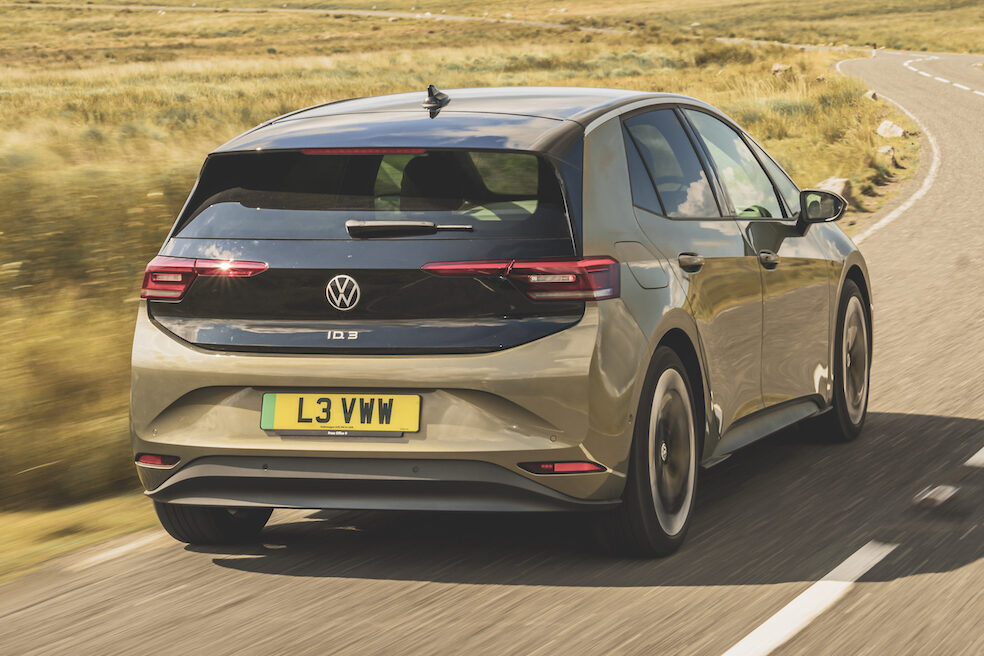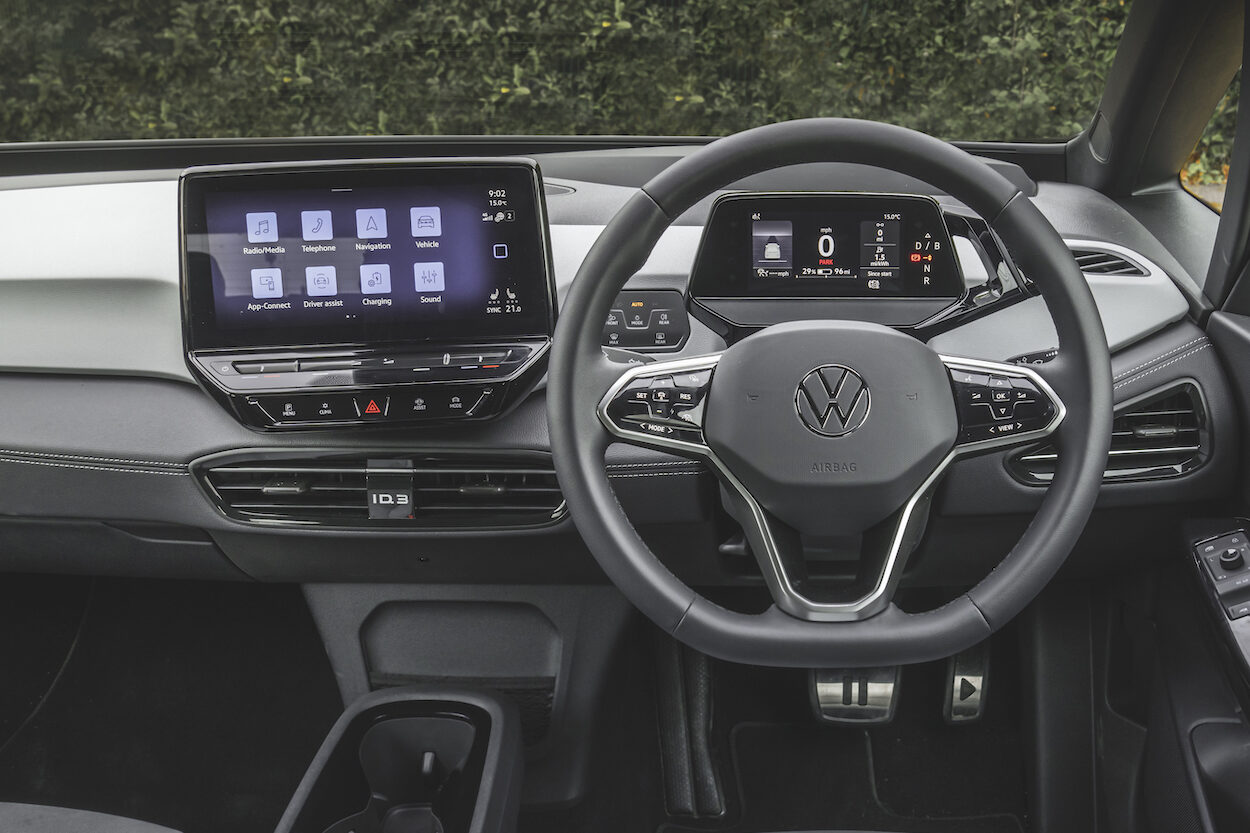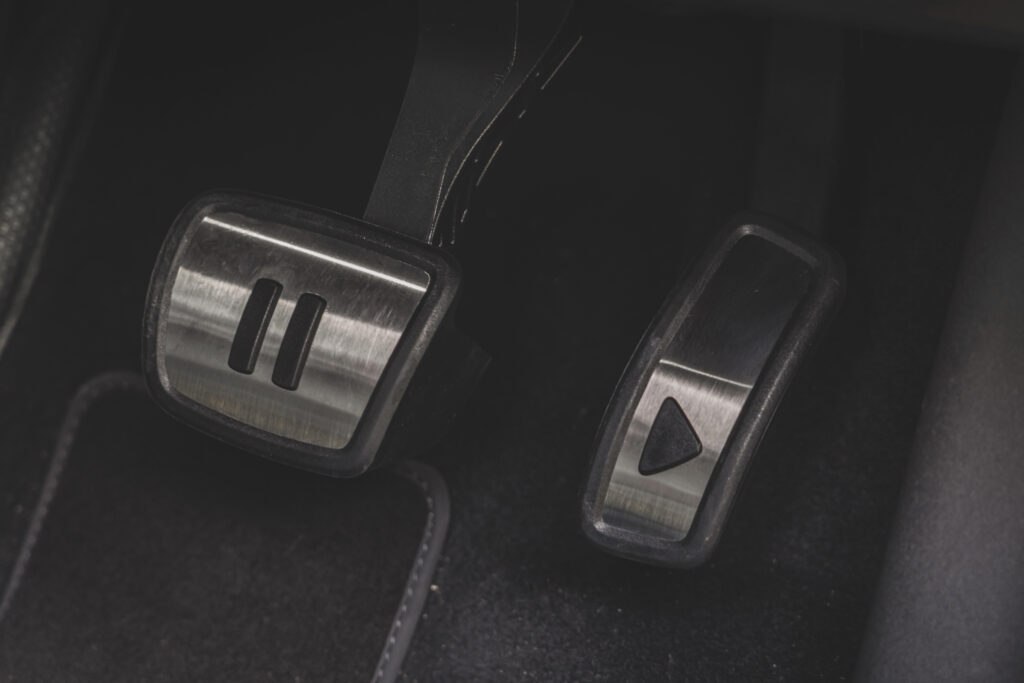It’s hard to deny that Volkswagen’s ID range of electric vehicles has lifted the German firm’s reputation out of the corporate disaster that was the dieselgate scandal. From the retro-familiarity of the ID Buzz to the mass market appeal of the ID3, ID4 and ID5, Volkswagen’s first half year of global EV sales in 2023 is up 48% on 2022.
There’s more to come too, with the larger ID7 coming in January 2024 and the ID2 due in 2025, plus this much-needed refresh to the ID3 range. The ID3 might be VW’s biggest seller in the ID line up with 49,800 sold, but the original was rushed to the market and somehow always felt like it too. From a glitchy infotainment system to some non-VW-feeling interior plastics, it was left a little wanting. So can this new facelifted version finally right those wrongs?
VOLKSWAGEN ID3 – DESIGN

It would be easy to criticise this new ID3 for what isn’t that extensive a facelift on the outside. But parked alongside the old version, it’s easy to see the detail changes that have been made. The black plastic at the top of the bonnet where it met the windscreen is now, thankfully, gone, as are the golf-ball dimples along the lower section of the front bumper and there are LED Matrix headlights.
The inside sees much improved materials on the dash with an updated infotainment system (thank goodness) and a new 10-inch dash screen with a larger 12-inch system coming in 2024. There’s also a head-up display system available and 71 per cent recycled materials used throughout which is to be praised.
VOLKSWAGEN ID3 – POWER AND RANGE

As before there are two battery versions of this revised ID3 with either 58kWh in the Pro model or 77kWh in the Pro S.
The 58kWh car has a 266 mile range with a 0 to 60mph time of 7.4 seconds and a 99mph top speed, while the larger battery’s equivalent numbers are 347 miles and 7.9 seconds with the same top speed. Volkswagen claims an efficiency rating of 4.0mls/kWh for both models, which for us seems to be a little on the low side as the previous model was closer to 4.5mls/kWh. Either way, we easily beat that official figure returning 4.3ms/kWh during our drive.
The 58kWh Pro model can take a recharge rate of up to 120kW and get from five to 80 per cent of charge in 35 minutes, while the 77kWh model can take a 170kW charge rate, shaving five minutes off that same charging time.
Rather tellingly, Volkswagen expects a 75/25 split in sales favouring the 58kWh model, whereas before it was a more even 50/50 split. Part of the reason is surely likely to be the issues surrounding the ID3’s interior seating – see below.
VOLKSWAGEN ID3 – ON THE ROAD

The original ID3 was hardly the last word in driver enjoyment and it’s much the same here. There’s a slightly lumpy ride at low speed on the 20in wheels of our test car, but that improves as your speed climbs.
Inside, there are four different driving modes to choose from – Eco, Comfort, Sport and Individual – while the regenerative braking can be adapted simply by switching from D to B. We’d prefer to have some slightly more aggressive options for the regenerative braking as even the strongest setting isn’t akin to the ‘one-pedal’ options in rivals.
The one piece of good news however is that despite those shortcomings, the ID3 can be hustled with a degree of verve and the rear-wheel drive set up gives it a sharp turn in to corners, so if the driver is willing, there are some rewards, albeit small. A new stronger rear axle is coming in 2024, more on which in the Interior section below, so perhaps that might also improve that driver feel further as well.
VOLKSWAGEN ID3 – INTERIOR

Inside is both this revised ID3’s biggest highlight – but also its biggest downfall.
First the good news. There are now soft materials on the dashboard and centre console, which sounds minor but actually makes a substantial improvement to the overall feel of the interior. There are 71 per cent recycled materials inside and the quality of the interior plastics feels like the car that Volkswagen should have launched originally.
The seats are comfortable enough with decent support and there is good rear seat space with two USB C charger ports for those in the back. Boot space is ok, if a little shallow. But, having said that, the rear visibility remains narrow and the heater and volume controls below the infotainment screen still aren’t easy to use on the move.
Why for instance, the passenger ventilation controls are right next to the on/off button is a mystery – more than once we turned the screen off by mistake. A larger 12in infotainment screen comes in 2024, but whether that will include changes to those controls is yet to be seen.
That big downfall however actually comes just over the driver’s left shoulder, with the rear seats. As hinted above, while the 58kWh Pro model comes with five seats, the larger 77kWh Pro S model is, rather surprisingly, only available with four seats. That stronger rear axle coming in 2024 we referred to earlier, will rectify this, but for the moment, if you want the flexibility of five seats, then you have to go for the smaller battery.
For us, this seems like a mistake. If this was a sports car or even a hot hatch, those kind of compromises might be acceptable, but this is a five door hatchback, the kind of car often bought by families. And for anyone who has a family, there will always be occasions where three children might need to sit in the back, whether it’s for a school run, sports practice or a whole host of reasons. Make no mistake, it puts a dent in the potential buyer appeal of the ID3.
SUMMARY
There are two elements to this verdict on the facelifted Volkswagen ID3. Is it better than the original? The answer is unquestionably yes. There are notable improvements, both in terms of its exterior styling and also the quality of those interior materials. Anyone stepping from the original ID3 to this model would immediately notice a difference.
But then there’s the other element about that seating, which ironically raises other issues. Why, for instance, didn’t Volkswagen wait until the new rear axle was available to launch all of the new additions to the ID3 range at the same time? Instead, it has a slight half measure that will presumably play havoc on the used market when these ID3s arrive onto it.
For us though, we can only deliver a verdict on this ID3 at this moment in time and that rear seat issue is likely to be a restriction on this car’s appeal especially for anyone with a family.
And that, in turn, is a problem for VW when there are talented rivals like the Kia Niro and MG4 that don’t have those same restrictions.

FACT BOX
Model: Volkswagen ID3 facelift
Price: from £37,115
Power: Battery – 58kWh, 77Wh
Range: 266-347 miles
Average efficiency: 4.0mls/kWh
Average charge time on a domestic wallbox: 8-10.5hrs
CO2 emissions: 0g/km
Rating: 7/10

